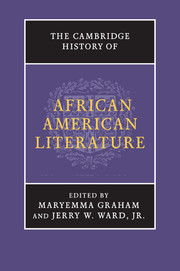Book contents
- Frontmatter
- Introduction
- PART I AFRICAN AMERICAN LITERATURE FROM ITS ORIGINS TO THE TWENTIETH CENTURY
- 1 Sounds of a tradition: the souls of black folk
- 2 Early print literature of Africans in America
- 3 The emergence of an African American literary canon, 1760–1820
- 4 Dividing a nation, uniting a people: African American literature and the abolitionist movement
- 5 African American literature and the abolitionist movement, 1845 to the Civil War
- 6 Writing freedom: race, religion, and revolution, 1820–1840
- 7 “We wish to Plead our own Cause”: independent antebellum African American literature, 1840–1865
- 8 Racial ideologies in theory and practice: political and cultural nationalism, 1865–1910
- 9 The “fictions” of race
- 10 “We Wear the Mask”: the making of a poet
- 11 Toward a modernist poetics
- PART II AFRICAN AMERICAN LITERATURE IN THE TWENTIETH CENTURY
- PART III AFRICAN AMERICAN LITERATURE AS ACADEMIC AND CULTURAL CAPITAL
- Bibliography
- Index
- References
10 - “We Wear the Mask”: the making of a poet
from PART I - AFRICAN AMERICAN LITERATURE FROM ITS ORIGINS TO THE TWENTIETH CENTURY
Published online by Cambridge University Press: 28 May 2011
- Frontmatter
- Introduction
- PART I AFRICAN AMERICAN LITERATURE FROM ITS ORIGINS TO THE TWENTIETH CENTURY
- 1 Sounds of a tradition: the souls of black folk
- 2 Early print literature of Africans in America
- 3 The emergence of an African American literary canon, 1760–1820
- 4 Dividing a nation, uniting a people: African American literature and the abolitionist movement
- 5 African American literature and the abolitionist movement, 1845 to the Civil War
- 6 Writing freedom: race, religion, and revolution, 1820–1840
- 7 “We wish to Plead our own Cause”: independent antebellum African American literature, 1840–1865
- 8 Racial ideologies in theory and practice: political and cultural nationalism, 1865–1910
- 9 The “fictions” of race
- 10 “We Wear the Mask”: the making of a poet
- 11 Toward a modernist poetics
- PART II AFRICAN AMERICAN LITERATURE IN THE TWENTIETH CENTURY
- PART III AFRICAN AMERICAN LITERATURE AS ACADEMIC AND CULTURAL CAPITAL
- Bibliography
- Index
- References
Summary
When Paul Laurence Dunbar wrote perhaps his most famous poem, “We Wear the Mask,” he knew of what he spoke. One of the first African American poets to make a living through literature and by far the best known of nineteenth-century African American poets, Dunbar garnered his fame by mastering dialect poetry of the so-called plantation tradition, a mode of writing that used phonetics to replicate a version of African American speech that white Southern writers had created for such stereotypical characters as happy darkies, picaninnies, sambos, coons, and mammies. Prominent in the novels and poetry of the period, these characters often expressed their own and their creators' nostalgia for the days of slavery. With support from some of the era's best-known writers and critics, some of whom, like regionalist James Whitcomb Riley, wrote this kind of verse, Dunbar traveled the country sharing with his mostly white audiences his versions of the wit and charm and humor associated with these stereotypical characters. Though Dunbar is given credit for writing more “authentic” versions, the mask to which he refers consists of the effects through which the racism, which was embedded in the literary tastes and conventions of the Reconstruction era, covered a truer face of black people. After all, the Reconstruction was the historical moment when the Northern states attempted between 1865 and 1877 to monitor former slaves' citizenship rights and social fortunes and to rebuild the Southern states after the Civil War.
- Type
- Chapter
- Information
- The Cambridge History of African American Literature , pp. 206 - 219Publisher: Cambridge University PressPrint publication year: 2011



